In the past two years, LoRa technology has been valued in China, from colleges and universities to entrepreneurs. As a company engaged in LoRa R&D for 3 years, it has launched 2 generations of LoRa gateways, and has contacted many customers who have inquired about LoRa technology. To this end, we explain some common problems with LoRa technology.
1Q: What is LoRa?
A: LoRa is short for Long Range and is a long-distance, low-power wireless communication technology. In 2009, French company Cycleo designed an excellent spread spectrum communication algorithm. Later, the company was acquired by Semtech, which launched the LoRa chip in 2013. Currently, semtech is the sole supplier of LoRa chips.
2Q: What is LoRaWAN?
A: LoRaWAN is the abbreviation of LoRa Wide Area Network (LoRa Wide Area Network), which is a communication protocol based on LoRa technology. It mainly includes three levels of communication entities: LoRa terminal, LoRa gateway and LoRa server.
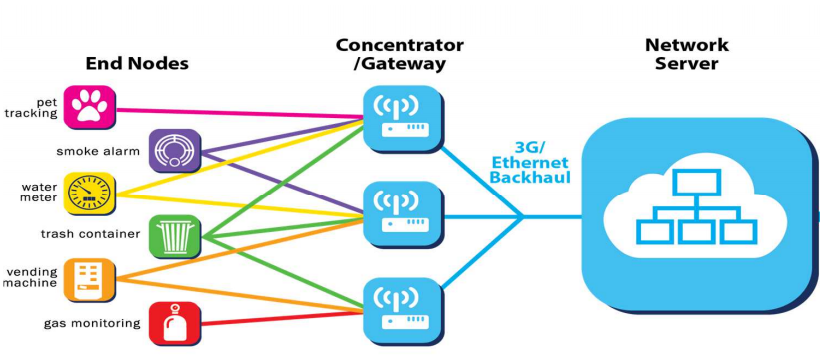
LoRaWAN is a relatively large architecture supporting CLASS A / B / C terminals. It uses the LoRa MAC protocol to provide anti-collision communication and synchronization mechanisms for gateways and terminals. There are four server roles: network connection and application management. , access control and user data. Its hierarchical relationship is as follows:
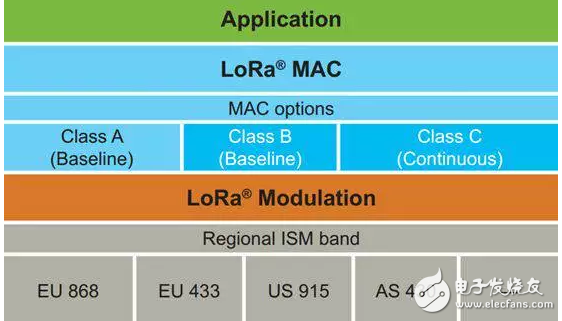
3Q: What are the advantages of LoRa?
A: The biggest advantage is long-distance transmission, using spread spectrum gain, its transmission distance is about 3 times FSK; secondly, it is low power consumption, although its communication distance can reach 5km, it still maintains good energy-saving characteristics; again, it Working in the free ISM band, this opens up a convenient door for ordinary people to use the wireless network, greatly reducing the cost of network deployment.
4Q: What are the disadvantages of LoRa?
A: The first drawback is that the transmission rate is low, because the communication bandwidth after spread-spectrum modulation is narrow, generally only suitable for sensor networks; the second disadvantage is that the hardware price is high, the time to market is not long, there is no large-scale application, and the cost is not Diluted; the third drawback, LoRaWAN core technology (communication protocols and algorithms) need to pay membership fees to obtain, which increases the cost and difficulty of research and development.
5Q: What is the difference between LoRa and common wireless technologies?
A: Indeed, there are many wireless technologies around us: 3G/4G, WiFi, Bluetooth and ZigBee. Why do you need LoRa wireless technology? In fact, each wireless technology can only adapt to a specific communication scenario, and it needs to be used together to build an efficient, low-cost network.
For example, modern military organizations and individual weapons are used together to achieve optimal firepower preparation.

6Q: What are the competitors of LoRa?
A: The three technologies that are representative of LPWAN (Low Power Wide Area Network) are: LoRa, Sigfox and LTE-M (including NB-IoT). Their technical parameters are compared as follows:
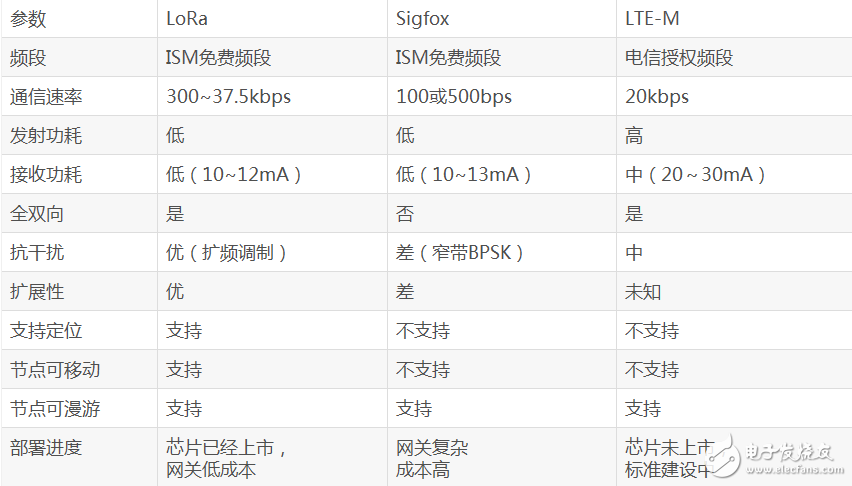
Question 7: Why can LoRa transmit farther?
A: The distance of wireless communication is affected by many factors, including: attenuation, loss, noise, atmospheric absorption, multipath and refraction. For a long time, the most direct way to extend the communication distance is to increase the transmission power, that is, to increase the Eb/N0 (the ratio of the energy per bit to the noise density per Hz), which cannot meet the requirements of low power consumption.
Later, it was discovered that the spread spectrum technique can achieve the following benefits: obtaining immunity from various types of noise and multipath distortion; and obtaining a gain of signal to noise ratio. In other words, the use of spread spectrum communication is more anti-interference and the communication distance is farther. The long distance of LoRa comes from here.
The schematic diagram of LoRa spread spectrum modulation is as follows. The original signal of the user data and the extended coded bit stream are XORed (exclusive OR) to generate a transmit signal stream. The effect of this modulation is that the bandwidth of the transmitted signal is significantly increased (expanded The spectrum).

8Q: What is SX1276/8 and SX1301?
A: SX1276/8 is the LoRa terminal chip launched by semtech, single channel, the former for the European and American markets (support 862 ~ 1020MHz), the latter for the Chinese market (does not support 862 ~ 1020MHz). From hardware design to software drivers, all open source designs are available for free download.
The SX1301 is a LoRa gateway chip from Semtech, with 8 LoRa channels and 1 FSK channel. It can be regarded as an FPGA+8-way LoRa modem. The chip is a core benefit block of semtech, from data sheets, to hardware parameters, to software drivers, to protocol algorithms, and is not publicly available; only when users pay and become a member of the LoRa Alliance, can they obtain relevant information and technology.
The architecture of the SX1301 is shown in the figure below. There are two front-end chips SX1255/7 processing signals. It is recommended that the GPS provide an accurate clock and connect to the MCU through SPI.
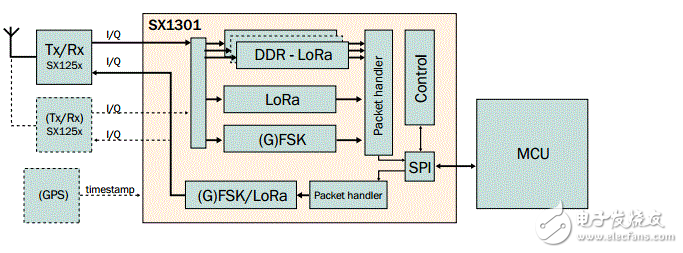
9Q: Is the LoRa gateway necessarily LoRaWAN+SX1301?
A: Broadly speaking, a gateway is a device that connects two different networks. If a device can connect the LoRa wireless network to the Internet, it is a LoRa gateway.
Depending on the application, LoRa gateways can be divided into at least portable, lightweight, regional, and carrier-grade; the first two, with fewer LoRa nodes and lower communication bandwidth, the LoRa gateway can use SX1276/8; Need SX1301, even multiple SX1301.
If the gateway and the terminal both use a company, the proprietary protocol can work; of course, to connect LoRa devices from different vendors, or even internationalization, it is necessary to follow the LoRaWAN protocol.
10 Q: What is the prospect of LoRa?
A: It is very difficult to predict the prospects of a young (only 3 years) IoT technology. In addition to technology, there are business models and political factors (guaranteeing basic data security and driving domestic employment). We try to compare LoRa with international and domestic competitors, and you may be able to see its prospects if you are smart.
Table 1 International

Table 2 Domestic
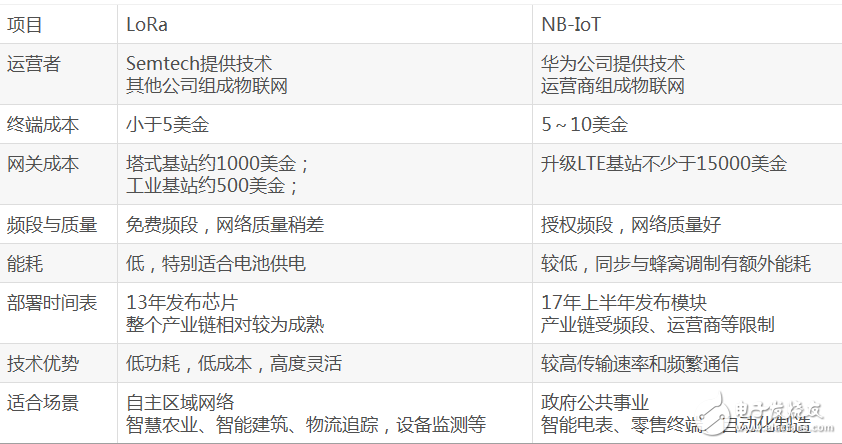
Photovoltaic New Energy Magnetic Ring Inductor
Photovoltaic New Energy Magnetic Ring Inductor,Common Mode Toroidal Inductors,High Frequency High Power Inductors,Three-Phase Common Mode Filter Inductor
Shenzhen Sichuangge Magneto-electric Co. , Ltd , https://www.scginductor.com